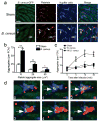Nucleation of platelets with blood-borne pathogens on Kupffer cells precedes other innate immunity and contributes to bacterial clearance
- PMID: 23770641
- PMCID: PMC4972575
- DOI: 10.1038/ni.2631
Nucleation of platelets with blood-borne pathogens on Kupffer cells precedes other innate immunity and contributes to bacterial clearance
Abstract
Through the use of intravital imaging of the liver, we demonstrate a collaborative role for platelets with Kupffer cells (KCs) in eradicating blood-borne bacterial infection. Under basal conditions, platelets, via the platelet-adhesion receptor GPIb, formed transient 'touch-and-go' interactions with von Willebrand factor (vWF) constitutively expressed on KCs. Bacteria such as Bacillus cereus and methicillin-resistant Staphylococcus aureus (MRSA) were rapidly caught by KCs and triggered platelets to switch from 'touch-and-go' adhesion to sustained GPIIb-mediated adhesion on the KC surface to encase the bacterium. Infected GPIbα-deficient mice had more endothelial and KC damage than did their wild-type counterparts, which led to more fluid leakage, substantial polycythemia and rapid mortality. Our study identifies a previously unknown surveillance mechanism by which platelets survey macrophages that rapidly converts to a critical host response to blood-borne bacteria.
Conflict of interest statement
The authors declare no competing financial interests.
Figures







Comment in
-
Platelet-macrophage partnership in innate immunity and inflammation.Nat Immunol. 2013 Aug;14(8):768-70. doi: 10.1038/ni.2666. Nat Immunol. 2013. PMID: 23867924 No abstract available.
References
-
- Crispe IN. The liver as a lymphoid organ. Annu Rev Immunol. 2009;27:147–163. - PubMed
-
- Katz S, Jimenez MA, Lehmkuhler WE, Grosfeld JL. Liver bacterial clearance following hepatic artery ligation and portacaval shunt. J Surg Res. 1991;51:267–270. - PubMed
-
- Rabinovitch M. Professional and non-professional phagocytes: an introduction. Trends Cell Biol. 1995;5:85–87. - PubMed
Publication types
MeSH terms
Substances
Grants and funding
LinkOut - more resources
Full Text Sources
Other Literature Sources
Medical
Molecular Biology Databases
Miscellaneous

